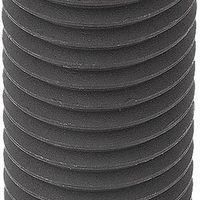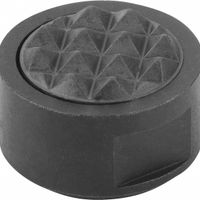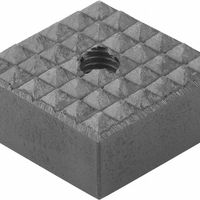Call +(254) 703 030 000 / 751 483 999 / 721 704 777
- Home
- Machining
- Clamping Workholding Positioning
- Indexing Positioning Equipment
- Positioning Grippers
.....Read More
Frequently Asked Questions
What are the different types of positioning grippers?
Positioning grippers are essential components in automation and robotics, used to manipulate and position objects. The different types include:
1. **Parallel Grippers**: These have two fingers that move in parallel to grip an object. They are ideal for handling objects with consistent shapes and sizes.
2. **Angular Grippers**: These grippers have fingers that open and close around a pivot point, suitable for applications where space is limited.
3. **3-Finger Grippers**: These provide a more secure grip by using three fingers, often used for handling cylindrical or irregularly shaped objects.
4. **Vacuum Grippers**: Utilizing suction cups, these grippers are perfect for handling flat, smooth surfaces like glass or metal sheets.
5. **Magnetic Grippers**: These use magnetic force to pick up ferrous materials, ideal for handling metal parts without the need for physical contact.
6. **Needle Grippers**: Equipped with needles that penetrate the surface of soft or porous materials, these are used in textile or foam handling.
7. **Adaptive Grippers**: These can adjust their grip to accommodate various shapes and sizes, often using flexible materials or advanced sensors.
8. **Soft Grippers**: Made from flexible materials, these grippers can handle delicate or irregularly shaped objects without causing damage.
9. **Servo-Electric Grippers**: These use electric motors for precise control over grip force and position, suitable for applications requiring high precision.
10. **Hydraulic/Pneumatic Grippers**: These use fluid or air pressure to operate, providing strong and reliable gripping force for heavy-duty applications.
Each type of gripper is designed for specific applications, considering factors like object shape, size, weight, and material.
How do threaded self-aligning grippers work?
Threaded self-aligning grippers are mechanical devices used to securely hold and manipulate objects with varying shapes and sizes. They operate using a combination of threaded mechanisms and self-aligning features to ensure a firm grip and adaptability to the object's contours.
The core component of these grippers is the threaded mechanism, typically a screw or bolt, which allows for precise control over the gripping force. As the screw is turned, it moves the gripping jaws closer together or further apart, adjusting the grip to accommodate different object sizes. This threaded adjustment provides a high degree of control over the pressure applied, ensuring that delicate objects are not damaged while still being held securely.
The self-aligning feature is achieved through the design of the gripper jaws, which are often mounted on pivot points or have flexible joints. This allows the jaws to automatically adjust their orientation to match the surface of the object being gripped. As a result, the gripper can maintain maximum contact with the object, distributing the gripping force evenly and reducing the risk of slippage.
In some designs, the jaws may have a compliant material or surface texture that enhances grip by increasing friction. This is particularly useful for handling smooth or slippery objects. The combination of threaded adjustment and self-aligning capability makes these grippers versatile and effective for a wide range of applications, from industrial automation to robotic systems.
Overall, threaded self-aligning grippers provide a reliable and adaptable solution for gripping tasks, ensuring secure handling of objects with minimal manual intervention.
What applications are positioning grippers used for?
Positioning grippers are used in a variety of applications across different industries due to their ability to precisely manipulate and position objects. Here are some key applications:
1. **Manufacturing and Assembly**: In automated production lines, positioning grippers are used to pick, place, and assemble components with high precision. They handle tasks such as inserting parts into assemblies, aligning components, and transferring items between workstations.
2. **Robotics**: In robotic systems, positioning grippers enable robots to perform tasks that require dexterity and accuracy, such as handling delicate or irregularly shaped objects, performing complex assembly operations, and conducting quality inspections.
3. **Material Handling**: In logistics and warehousing, positioning grippers are employed to sort, pick, and place items onto conveyors, pallets, or storage systems. They enhance efficiency in packaging, order fulfillment, and inventory management.
4. **Automotive Industry**: Grippers are used in the automotive sector for tasks like assembling car parts, handling heavy components, and performing quality checks. They contribute to the automation of processes such as welding, painting, and part inspection.
5. **Electronics and Semiconductor Manufacturing**: In these industries, positioning grippers handle small, delicate components with precision, aiding in the assembly of circuit boards, placement of microchips, and testing of electronic devices.
6. **Food and Beverage**: Grippers are used to handle food products, packaging, and containers, ensuring hygiene and precision in processes like sorting, packaging, and palletizing.
7. **Medical and Pharmaceutical**: In these sectors, grippers assist in the handling of medical devices, packaging of pharmaceuticals, and assembly of medical equipment, ensuring compliance with stringent hygiene and safety standards.
8. **Aerospace**: Positioning grippers are used for assembling aircraft components, handling materials, and performing maintenance tasks, where precision and reliability are critical.
These applications highlight the versatility and importance of positioning grippers in enhancing automation, efficiency, and precision across various industries.
How do hex-head gripper screws differ from other grippers?
Hex-head gripper screws differ from other grippers primarily in their design, functionality, and application. These screws feature a hexagonal head, which allows for easy tightening and loosening using a wrench or socket. This design provides a more secure grip and greater torque compared to other types of gripper screws, such as slotted or Phillips-head screws, which are typically adjusted using a screwdriver.
The hex-head design is particularly advantageous in applications requiring high precision and stability, as it minimizes the risk of slippage during adjustment. This makes hex-head gripper screws ideal for use in environments where vibration or movement could cause other types of screws to loosen.
Additionally, hex-head gripper screws often incorporate a knurled or textured surface on the gripping end, enhancing their ability to hold components securely in place. This feature is especially useful in applications involving delicate or sensitive materials, as it reduces the likelihood of damage during installation or adjustment.
In contrast, other grippers may not offer the same level of torque or grip security, potentially leading to less reliable performance in demanding conditions. Furthermore, the hex-head design allows for easier access in tight spaces, as the wrench or socket can engage the screw head from multiple angles, unlike a screwdriver which requires direct alignment.
Overall, hex-head gripper screws provide a combination of strength, precision, and ease of use that distinguishes them from other grippers, making them a preferred choice in many industrial and mechanical applications.
What materials are suitable for square gripper pads?
Suitable materials for square gripper pads include:
1. **Rubber**: Offers excellent grip and flexibility. It is durable and can withstand various environmental conditions, making it ideal for applications requiring a strong hold.
2. **Silicone**: Known for its high temperature resistance and non-slip properties. Silicone is also chemically inert, making it suitable for handling sensitive or delicate items.
3. **Polyurethane**: Provides a good balance between flexibility and toughness. It is resistant to abrasion and can handle repeated use without significant wear.
4. **Neoprene**: Offers good chemical resistance and durability. It is also resistant to oil and weathering, making it suitable for industrial applications.
5. **EPDM (Ethylene Propylene Diene Monomer)**: Known for its excellent weather and ozone resistance. It is also resistant to heat and provides a good grip.
6. **Nitrile Rubber (Buna-N)**: Offers excellent resistance to oils and fuels. It is durable and provides a strong grip, making it suitable for automotive and industrial applications.
7. **Cork**: Provides a natural, non-slip surface. It is lightweight and can be used in applications where a softer touch is required.
8. **Foam**: Lightweight and provides cushioning. It is suitable for applications where gentle handling is necessary.
9. **Thermoplastic Elastomers (TPE)**: Combines the properties of rubber and plastic, offering flexibility and durability. It is suitable for applications requiring a soft touch and good grip.
10. **PVC (Polyvinyl Chloride)**: Offers good grip and is resistant to chemicals and abrasion. It is suitable for various industrial applications.
These materials are chosen based on factors such as grip strength, durability, environmental resistance, and the specific requirements of the application.
How do round gripper inserts provide strong gripping force?
Round gripper inserts provide strong gripping force through several key mechanisms. Firstly, their circular design allows for even distribution of pressure across the contact surface, minimizing stress concentrations and reducing the risk of slippage. This uniform pressure distribution ensures that the object being gripped is held securely without causing damage.
The material composition of round gripper inserts is another critical factor. They are often made from high-friction materials such as rubber, polyurethane, or specialized polymers that enhance grip by increasing the coefficient of friction between the insert and the object. This high-friction interface is crucial for maintaining a strong hold, especially in applications involving smooth or slippery surfaces.
Additionally, the surface texture of round gripper inserts can be engineered to further enhance grip. Textured or patterned surfaces increase the contact area and create additional frictional forces, which help in securing the object more effectively. These textures can include ridges, grooves, or other micro-patterns that interlock with the surface of the object being gripped.
The mechanical design of the gripper system also plays a role. Round gripper inserts are often part of a larger gripping mechanism that applies force uniformly and can adjust to different object sizes and shapes. This adaptability ensures that the gripping force is optimized for each specific application, providing a secure hold without excessive force that could damage the object.
Finally, the inherent flexibility of round gripper inserts allows them to conform to the shape of the object, increasing the contact area and enhancing the grip. This adaptability is particularly useful for irregularly shaped objects, ensuring a consistent and reliable gripping force across various applications.
What are the benefits of using fully-threaded self-aligning grippers?
Fully-threaded self-aligning grippers offer several benefits in industrial and robotic applications:
1. **Enhanced Alignment**: These grippers automatically adjust to the orientation of the object being handled, reducing the need for precise positioning and alignment. This self-aligning capability minimizes errors and increases efficiency in operations.
2. **Versatility**: They can handle a wide range of object shapes and sizes due to their adaptable nature. This versatility makes them suitable for various applications, from manufacturing to assembly lines.
3. **Improved Grip**: The fully-threaded design provides a secure and stable grip on objects, reducing the risk of slippage or dropping. This is particularly beneficial in handling delicate or irregularly shaped items.
4. **Reduced Wear and Tear**: The self-aligning feature reduces the stress and strain on the gripper components, leading to less wear and tear over time. This extends the lifespan of the gripper and reduces maintenance costs.
5. **Increased Efficiency**: By minimizing the need for manual adjustments and realignments, these grippers streamline operations, leading to faster cycle times and increased productivity.
6. **Cost-Effective**: The durability and reduced maintenance requirements of fully-threaded self-aligning grippers contribute to lower operational costs. Their ability to handle various tasks also reduces the need for multiple specialized grippers.
7. **Safety**: A secure grip reduces the likelihood of accidents caused by dropped or mishandled objects, enhancing workplace safety.
8. **Ease of Integration**: These grippers can be easily integrated into existing systems, offering flexibility in upgrading or expanding automation processes.
Overall, fully-threaded self-aligning grippers provide a reliable, efficient, and cost-effective solution for handling diverse objects in automated environments.





